Tag Archives: Ramananda Raya
Ramananda Raya – Video
Before, Shri Chaitanya Mahaprabhu met Ramananda Raya, Sarvabhauma Bhattacharya told the Lord that no other Devotee’s knowledge of Radha-Krishna’s madhurya rasa compares with Ramananda Raya’s. Although Lord Chaitanya was half the age of forty year old Ramananda when they met, the Lord said, “My dear Ramananda, both you and I are madmen and therefore we meet intimately on an equal level.” Outwardly he acted as the Governor of Madras, but he was a poet, Sanskrit scholar, a dramatist well-versed in rasa literature, music, singing, dancing

Ramananda Raya – ebooks
Ramananda Raya – Biography 2
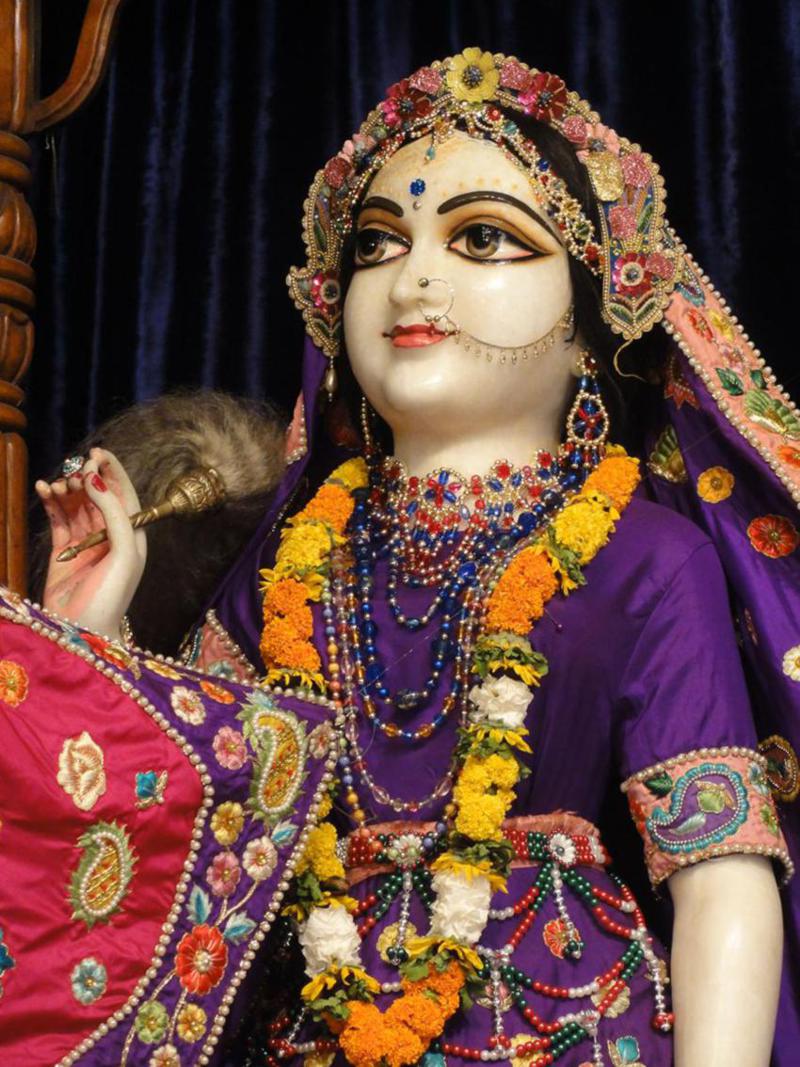
Shrila Bhaktivinoda Thakur writes, "The same love which Vishakha had for Radha and Krishna in Vraja, and that love which Radha and Krishna had for Vishakha, awakened in them when they met." Thus it is clear that Shrila Bhaktivinoda Thakur saw Ramananda Raya as Vishakha. (In the image: Shrimati Vishakha Devi, ISKCON Mayapur, India).

By Krishna’s will, the creator Brahma himself appeared in an outcaste family in order to show that one’s family and one’s race have absolutely no importance. Born as a Muslim, Hari Das still enriched Lord Gauranga’s pastimes. (In the wallpaper: Shrila Haridas Thakur, background image is Harinaam Sankirtan in Poland).

Mental speculation is of no value for understanding the nature of the Supreme Lord. Without the Lord’s mercy, no person can come to know Him. One to whom the Lord gives even a slight drop of mercy is able to understand His nature. (Chaitanya Charitamrita 2.6.82-3) (In the image: Lord Vishnu on Garuda, suffering living entity).

He went on to the Godavari River,...hoping to meet Ramananda Raya. Coming out of the water, He sat down and waited for him...At the same time, Ramananda Raya passed by with a fanfare. When he saw Mahaprabhu’s supernatural form, he descended from his palanquin and paid his obeisances to the Lord. Though Mahaprabhu recognized him, He asked him to identify himself. Ramananda replied that he was nothing but a lowly shudra servant. When the Lord heard him speak in this humble manner, He immediately embraced him. Both the Lord and His servant felt the onset of divine emotions and the both experienced the eight ecstatic transformations of prema. The Brahmins who were accompanying Ramananda were astonished to see such a display. They thought, "This sannyasi is as effulgent as the brahmajyoti. Why is He crying while embracing this shudra? The governor Ramananda is a scholar and normally very serious. Why has become so emotional upon being touched by this sannyasi, as though intoxicated?" (Chaitanya Charitamrita 2.8.26-7) (In the wallpaper: Shri Gauranga Mahaprabhu, Ramananda Raya, local brahmanas, background image of the Godavari river).
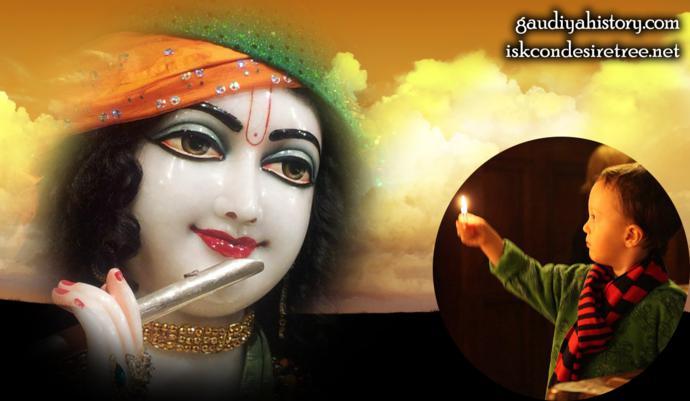
"Pure devotional service without any tinge of speculative knowledge (jnana-shunya-bhakti ) is the means to achieve the supreme perfection." (In the wallpaper: Shri Krishna, ISKCON Chennai, a Devotee boy).
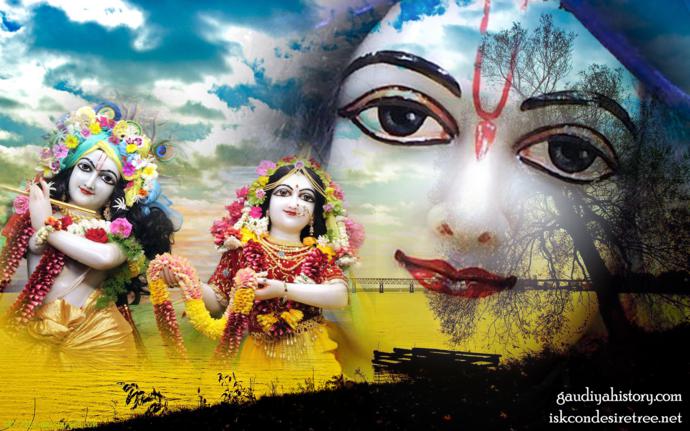
"First I saw You as an ordinary sannyasi. Now I see that You are actually a dark-skinned cowherd boy. I see a golden puppet standing in front of You; its golden effulgence covers Your entire body." (Chaitanya Charitamrita 2.8.268-9)...Mahaprabhu was pleased with his insightful realization and He displayed His form as the combination of rasa-raja ("the king of the devotional sentiments") Krishna and the incarnation of maha-bhava ("the supreme devotional mood"), Shrimati Radharani. When he saw this amazing combined form of the Lord, Ramananda Raya fell to the ground in a faint. When the Lord touched him, he regained consciousness. (In the wallpaper: Shri Shri Radha Gopinath, Shri Gaurachandra, ISKCON Chowpatty, Mumbai).
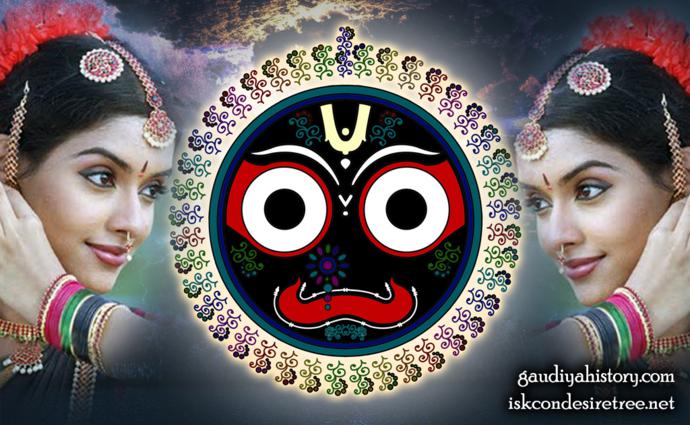
"...He personally serves Jagannath’s young and beautiful devadasis in every possible way. He personally bathes and dresses them and decorates them with ornaments. While doing so, he naturally sees and touches the private parts of their bodies, but even so, his mind is never affected. He teaches the girls how to physically express all the moods of love, to be acted out before Jagannath Deva, but his mind and body are as steady as wood or stone. Indeed, it is amazing that even when he touches such young girls, his mind is not disturbed. Only Ramananda has the right to do such things, and seeing him do them, I can understand that his body is not material but has been completely transformed into a spiritual entity." (Chaitanya Charitamrita 2.5.35-42) (In the wallpaper: Lord Jagannath, the devadasi).
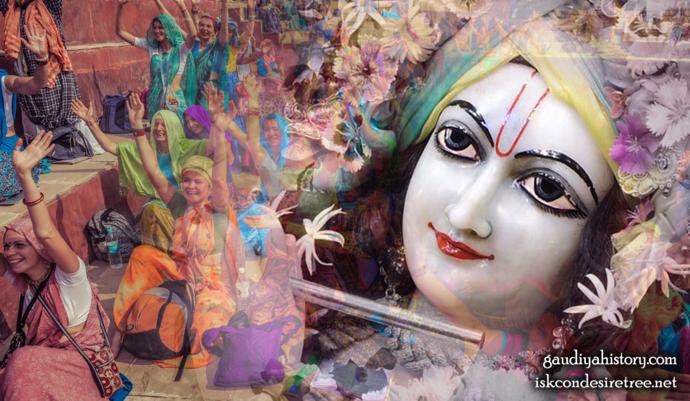
"Listen Svarupa Damodar and Ramananda Raya! In the age of Kali, Harinama sankirtan is the supreme means of deliverance. In the age of Kali, Krishna is to be worshiped by the congregational chanting of His Holy Names. This is the way that an intelligent person attains the lotus feet of Krishna. Through the chanting of the Holy Name, all of one’s sinful reactions are extinguished and all auspiciousness arises until finally one experiences the joys of love for Krishna." (Chaitanya Charitamrita 3.20.8-11) (In the wallpaper: Shri Gopinath, ISKCON Chowpatty, Mumbai, Devotees from Europe in Prem Sarovar, Shri Vrindavan Dham).
Ramananda Raya – Biography 3
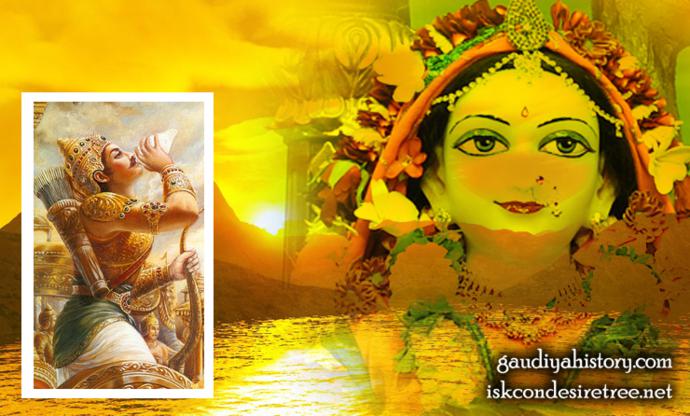
The Gauraganoddeshadipika (120-124) states that Ramananda Raya was Arjuna in his past incarnation. He is also considered to have been an incarnation of the gopi Lalita..." (In the wallpaper: Shri Lalita Sakhi in the right, ISKCON Chowpatty, Mumbai, Arjuna).
Ramananda was the Governor of East and West Godavari and a minister of King Prataparudra. A great statesman of that period, Ramananda was also a poet and a scholar.
When Bhavananda met Shri Chaitanya Mahaprabhu, the Lord embraced him and said, "Formerly you appeared as Pandu, and your five sons appeared as the five Pandavas."
The five sons of Bhavananda Raya were Ramananda Raya, Pattanayaka Gopinatha, Kalanidhi, Sudhanidhi and Nayaka Vaninatha.
The Gauraganoddeshadipika (120-124) states that Ramananda Raya was Arjuna in his past incarnation. He is also considered to have been an incarnation of the gopi Lalita, although in the opinion of others he was an incarnation of Visakha Devi. He was a most confidential Devotee of Lord Chaitanya. Lord Chaitanya said, "Although I am a sannyasi, My mind is sometimes perturbed when I see a woman. But Ramananda Raya is greater than Me, for he is always undisturbed, even when he touches a woman."
Only Ramananda Raya was able to act in this way, no one should imitate him. Unfortunately there are rascals who imitate the activities of Ramananda Raya.
In Lord Chaitanya's final pastimes, both Ramananda Raya and Svarupa Damodara were always engaged in reciting suitable verses from Shrimad Bhagavatam to pacify the Lord in His ecstatic feelings of separation from Krishna. When Lord Chaitanya was about to leave for South India, Sarvabhauma Bhattacharya advised Him to meet Ramananda Raya for he declared that there was no Devotee as advanced in understanding the conjugal love of Krishna and the gopis.
While touring South India Lord Chaitanya met Ramananda on the bank of the Godavari. There they had a long discourse in which the Lord took the role of a student and Ramananda Raya instructed the Lord. Lord Chaitanya concluded these discourses by saying, "My dear Ramananda Raya, both you and I are madmen, and therefore we met intimately, on an equal level." Lord Chaitanya advised Ramananda Raya to resign from his government post and come back to Jagannatha Puri to live with Him. It was Ramananda Raya who tactfully arranged a meeting between Lord Chaitanya and King Prataparudra of Orissa. Ramananda Raya was present when the Lord performed water-sports after the Rathayatra festival.
Lord Chaitanya considered Ramananda Raya and Sanatana Goswami to be equal in their renunciation, for although Ramananda Raya was a grihasta engaged in government service and Sanatana Goswami was in the renounced order of complete detachment from material activities, they were both servants of the Supreme Personality of Godhead and kept Krishna in the center of all their activities. Ramananda Raya was one of the three and a half personalities with whom Lord Chaitanya discussed most confidential topics of Krishna Consciousness.
Lord Chaitanya advised Pradyumna Mishra to learn the science of Krishna from Ramananda Raya. As Subala always assisted Krishna in His dealing with Radharani in Krishnalila, so Ramananda Raya assisted Lord Chaitanya in His feelings of separation from Krishna. Ramananda Raya was the author of Jagannatha-vallabha-nataka.
In Ishwar dasa's Chaitanya Bhagavata (ed. A.B. Mohanty, Utkal University) a comprehensive description is given of Lord Chaitanya's relationship with Ramananda Raya.
After hearing Ramananda Raya speak about the essence of premabhakti, Lord Chaitanya, with tears in His eyes and overwhelmed with emotion, warmly embraced Ramananda.
In the Gurbhaktigita of Achyutananda dasa (Utkal University Vol. 3, Chapter XLIX P. 176) the author describes Ramananda as Vishakha, which is supported by Svarupavarnana (ms. of Rupa Goswami preserved in Utkal University Library, Catalogue no. O.L. 382 ) and Chaitanyaganoddesha (ms. of Sadashiva Kaviraja, preserved in Orissa State Museum).
Lord Chaitanya's discourses with Raya Ramananda are fully described in CC.
First of all, Shrila Ramananda Raya enunciated the system of the varnashrama institution.
He recited various verses about karmarpana, stating that everything should be dedicated to the Lord.
He then spoke of detached action, knowledge mixed with devotional service, and finally the spontaneous loving service of the Lord.
After hearing Shrila Ramananda Raya recite some verses, Shri Chaitanya Mahaprabhu accepted the principle of pure devotional service devoid of all the kinds of speculation.
After this, Shri Chaitanya Mahaprabhu asked Ramananda Raya to explain the higher platform of devotional service.
Then Shrila Ramananda Raya explained unalloyed devotional service, love of Godhead, serving the Lord with pure servitude as well as in fraternity and parental love.
Finally he spoke of serving the Lord in conjugal love. He then spoke of how conjugal love can be developed in various ways.
This conjugal love attains its highest perfection in Shrimati Radharani's love for Krishna.
He next described the position of Shrimati Radharani and the transcendental mellows of love of God.
Shrila Ramananda Raya then recited one verse of his own concerning the platform of ecstatic vision, technically called prem-vilasa-vivarta.
Shrila Ramananda Raya also explained that all stages of conjugal love can be attained through the mercy of the residents of Vrindavana, especially by the mercy of the gopis.
The meeting of Lord Chaitanya and Shri Ramananda Raya is further described in GPC. After bathing in the River Godavari, the Lord walked a little distance from the bathing place and engaged in chanting the Holy Name of Krishna. At that time, accompanied by the sounds of music, Ramananda Raya came there mounted on a palanquin to take his bath. Many brahmanas, following the Vedic principles, accompanied Ramananda Raya. According to the Vedic rituals, Ramananda Raya took his bath and offered oblations to his forefathers.
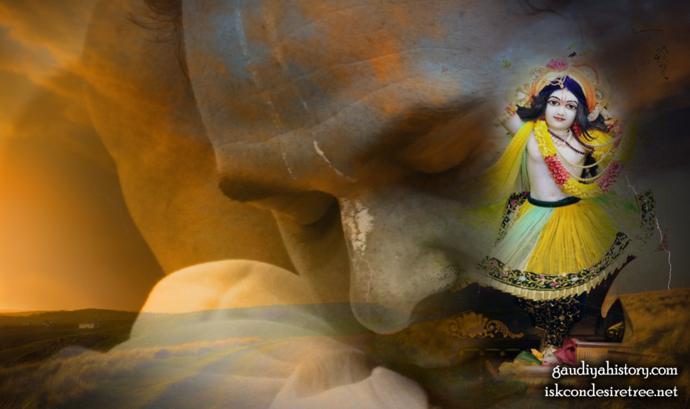
Shri Chaitanya Mahaprabhu then inquired whether he was Ramananda Raya, and he replied, "Yes I am Your very low servant, and I belong to the shudra community." The Lord then embraced him very firmly. Indeed, both the master and the servant almost lost consciousness due to ecstatic love. (In the wallpaper: Shri Gaurachandra, ISKCON Chowpatty, Mumbai, in the background image Devotees' hug).
Shri Chaitanya Mahaprabhu could understand that the person who had come to bathe in the river was Ramananda Raya. The Lord wanted so much to meet him that His mind immediately began running after him. Although the Lord was running after him mentally, He patiently remained sitting. Ramananda Raya, seeing the wonderful sannyasi, then came to see Him. Shrila Ramananda Raya then saw Shri Chaitanya Mahaprabhu as brilliant as a hundred suns. The Lord was covered by a saffron garment. He was large in body and very strongly built, and His eyes were like lotus petals. When Ramananda Raya saw the wonderful sannyasi, he was struck with wonder. He went to Him and immediately offered his respectful obeisances, falling down like a rod. The Lord stood up and asked Ramananda Raya to arise and chant the Holy Name of Krishna.
Shri Chaitanya Mahaprabhu then inquired whether he was Ramananda Raya, and he replied, "Yes I am Your very low servant, and I belong to the shudra community." The Lord then embraced him very firmly. Indeed, both the master and the servant almost lost consciousness due to ecstatic love.
After composing themselves, they sat down and Shri Chaitanya Mahaprabhu said, "Sarvabhauma Bhattacharya has spoken of your good qualities, and he has made a great endeavor to convince Me to meet you.
Indeed I have come here just to meet you. It is very good that even without making an effort I have gotten your interview here." Ramananda Raya replied, "Sarvabhauma Bhattacharya thinks of me as his servant. Even in my absence he is very careful to do me good. By his mercy I have received Your interview here. Consequently I consider that today I have become a successful human being. I can see that You have bestowed special mercy upon Sarvabhauma Bhattacharya. Therefore You have touched me, although I am untouchable. This is due only to his love for You. You are the Supreme Personality of Godhead, Narayana Himself, and I am only a government servant interested in materialistic activities. Indeed, I am the lowest amongst men of the fourth caste. You do not fear the Vedic injunctions stating that You should not associate with a shudra. You were not contemptuous of my touch, although in the Vedas You are forbidden to associate with sudras.
At this time a brahmana Vaishnava came and invited the Lord for lunch, and after arranging to meet Ramananda Raya again later the Lord departed.
After finishing His evening bath, Shri Chaitanya Mahaprabhu sat down and waited for Ramananda Raya to come. Then Ramananda Raya, accompanied by one servant, came to meet Him. He offered his respectful obeisances, and the Lord embraced him. Then they both began to discuss Krishna in a secluded place for the entire night. Again the next evening Shri Ramananda Raya visited Mahaprabhu and paid obeisances.
Mahaprabhu fondly embraced him and began questioning him as follows :
Q: What is the best education among all kinds of learning?
A: Devotion for Krishna is by far the best learning.
Q: What is the achievement of a living being?
A: The best glory is to take the post of servant of Shri Radha and Krishna.
Q: What is the best religion for a living being?
A: Love for Shri Radha-Govinda is the best religion.
Q: Which creature suffers the most?
A: A Devotee who is suffering due to separation from the Lord.
Q:Who is the most liberated person?
A:One who loves Krishna is the most renounced person.
Q: Which is the best song?
A: Songs about the pastimes of Radha and Krishna.
Q: What is the greatest well being for a living entity?
A: The association of Krishna's Devotees.
Q: What is the only thing to remember?
A: Krishna's name, beauty and qualities.
Q: What is the only object of meditation?
A: The lotus feet of Radha Govinda.
Q: Which is the best place for a living entity to reside?
A: The place where Krishna's pastimes are performed.
Q: What is the best thing to hear?
A: The loving pastimes of Radha-Govinda
Q: What is the only subject matter for a living entity to sing?
A: The name of Radha Govinda.
Q: What is the fate of a person who has worldly desires and of a man who desires liberation?
A: Animate body, and celestial body.
Q: What are the characteristics of a Devotee and of a knowledgeable person?
A: A so called intelligent person, who is like a crow, eats the fruits of wisdom from the bitter Neem tree, whereas the Devotee is a cuckoo who drinks the nectar of love.
Gradually Ramananda Raya could understand the position of Shri Chaitanya Mahaprabhu, and when the Lord exhibited His real form, Ramananda Raya fell unconscious.
The Lord then requested Ramananda Raya, "Now there is no confidential activity unknown to you. Keep all these talks a secret. Please do not expose them anywhere and everywhere. Since My activities appear to be like those of a madman, people may take them lightly and laugh. Indeed, I am a madman, and you are also a madman. Therefore both of us are on the same platform."
The next day, Shri Chaitanya Mahaprabhu begged Ramananda Raya to give Him permission to leave, and at the time of farewell the Lord gave him the following orders:
"Give up all material engagements and come to Jagannatha Puri. I will return there very soon after finishing My tour and pilgrimage. The two of us shall remain together at Jagannatha Puri and happily pass our time discussing Krishna."
Later, with the permission of King Prataparudra, Ramananda Raya went to Puri. Shri Svarupa Damodara was the dear-most friend of Shri Ramananda Raya. Having written dramas on the pastimes of Krishna, Ramananda had them performed before Shri Jagannatha Deva by the Devadasis of the Temple. Shri Ramananda Raya died after the disappearance of Shri Chaitanya Mahaprabhu.
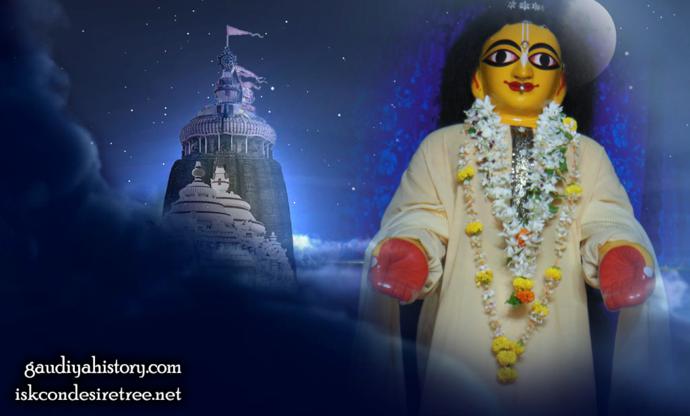
"Give up all material engagements and come to Jagannatha Puri. I will return there very soon after finishing My tour and pilgrimage. The two of us shall remain together at Jagannatha Puri and happily pass our time discussing Krishna." (In the wallpaper: Shri Dhameshvar Mahaprabhu, Nadia, West Bengal, Jagannatha Puri Temple).
Ramananda Raya – Audio
Ramananda Raya – Gallery
Ramananda Raya
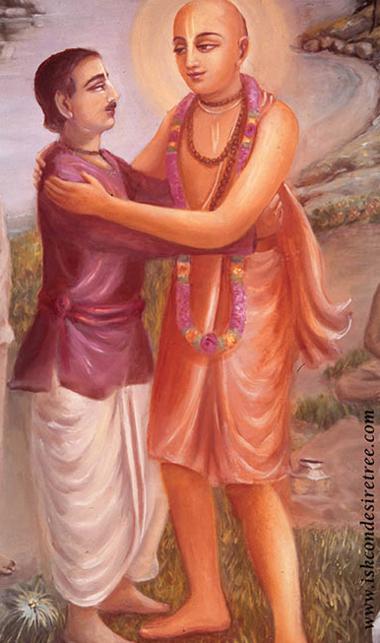
"My dear Ramananda, both you and I are madmen and therefore we meet intimately on an equal level." Outwardly he acted as the Governor of Madras, but he was a poet, Sanskrit scholar, a dramatist well-versed in rasa literature, music, singing, dancing...(In the image: from left to right Ramananda Raya and Shri Chaitanya Mahaprabhu).
During their ten day meeting in Vidyanagara, Lord Gauranga and Ramananda Raya discussed all points of Krishna consciousness. Empowered by the Lord, Ramananda answered all questions posed by Shri Chaitanya Mahaprabhu. Gaudiya Vaishnava acharyas have given lengthy discourses on, "Talks between the Lord and Ramananda Raya." (Chaitanya-charitamrta Madhya Ch.8) These talks are called Ramananda Samvagh.
Ramananda Raya gave a series of answers to Lord Chaitanya's first question, "How to attain the ultimate goal of life?' He began with varnashrama-dharma, and progressed to karmarpana, karmatyaga, jnana-mishra-bhakti, Radha-bhakti, prema bhakti, (dasya, sakhya, vatsalya, madhurya prema), and Radha-prema. He also described Krishna-tattva, Radha-tattva, Radha-Krishna prema-tattva, and finally prema-vilasa vivarta. Confirming that this was the highest goal of life, Lord Chaitanya asked Ramananda how to attain it.
Ramananda Raya said, "Without adopting the mood of the gopis and following in their footsteps, one cannot enter the confidential pastimes of Radha-Krishna. There is no other way to achieve the service of Radha and Krishna within the pleasure groves of Vrindavana.
The gopis don't have any desires for their personal sense enjoy-ment. Their minds and bodies exist only for Krishna's enjoyment. If one is greedy to taste the nectar of gopi-bhava (spontaneous loving mood of the gopis), he will give up the world and the rituals of Vedic dharma to perform Krishna bhajana. One who worships Shri Krishna on the path of raganuga-bhakti will attain Vrajendra-Nandana in Vrindavana. However one cannot attain the blissful association of Krishna-chandra in Vrindavana by merely following vidhi-marga (path of serving Krishna by regulative principles). Therefore, one should accept gopi bhava and always remember Radha-Krishna all day and night." (Chaitanya-charitamrta Madhya 8.201-233).
After finishing his talk, Ramananda Raya saw something never seen before. Shri Chaitanya Mahaprabhu revealed Himself as both Shrimati Radharani and Shri Krishna. Seeing this, Ramananda fell unconscious in transcendental bliss.
In Jagannatha Puri, Shrila Svarupa Damodara Goswami, another topmost rasika Vaishnava, joined Ramananda Raya to intimately serve Shri Gauranga Mahaprabhu. Together they helped Mahaprabhu taste the loving ecstacies of madhurya rasa. In His Gambhira lila Shri Chaitanya would stay up all night enraptured in Shrimati Radharani's mood of separation from Shyamasundara. Singing his own songs and the poems of Vidyapati and Chandidasa, Ramananda Raya would delight Lord Gauranga with his enchanting melodies. Krishna Dasa Kaviraja says that when Shri Chaitanya Mahaprabhu felt intense pains of separation from Shri Krishna, only Ramananda's talks about Krishna and Svarupa Damodara's sweet songs kept Him alive.
Ramananda Raya was the first person to reveal the deep varieties of rasa which Lord Chaitanya privately savored within Himself. He saw Shri Chaitanya Mahaprabhu as the combined form of Rasaraja-Mahabhava. Rasaraja Shri Krishna and Mahabhava svarupini-Shri Radha now appeared in one beautiful dazzling form.
Lord Chaitanya once said, "Although I am in the renounced order of life, still My mind is sometimes disturbed even upon seeing a wooden form of a woman. But Ramananda Raya is greater than Me. For he always remains undisturbed even when he touches a young woman." Of course, even in dreams, no one should attempt to imitate the extraordinary behavior of Shri Ramananda Raya. He was teaching young girls, the devi-dasis, to portray his rasa-laden dramas by dancing in the Temple for Lord Jagannatha's pleasure. He would also bathe, massage, and dress the bodies of the beautiful girls. In all of creation, only Ramananda Raya possesses this quality of total self-control and absolute detachment.
Upon meeting Bhavananda Raya, the father of Ramananda, Lord Gauranga said, "Indeed, you are "Pandu" and your five sons–Ramananda, Gopinatha, Vaninatha, Kalanidhi, Sudhanidhi–are the five Pandavas."

Ramananda Raya was the first person to reveal the deep varieties of rasa which Lord Chaitanya privately savored within Himself. He saw Shri Chaitanya Mahaprabhu as the combined form of Rasaraja-Mahabhava. Rasaraja Shri Krishna and Mahabhava svarupini-Shri Radha now appeared in one beautiful dazzling form. (In the wallpaper: Shri Shri Radha Krishna in two sides and Shri Gauranga Mahaprabhu, ISKCON Chennai).

